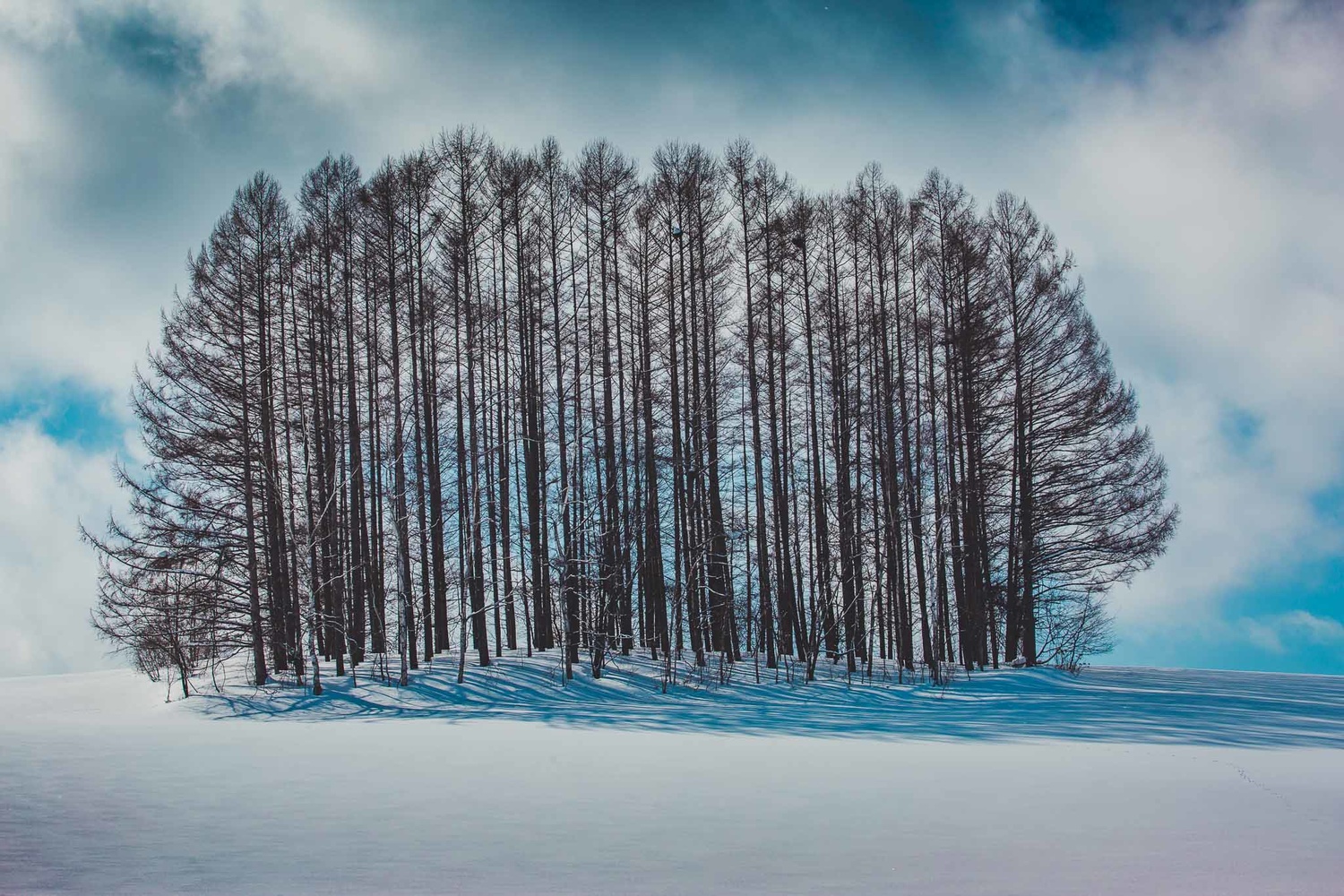I've recently returned from Hokkaido, Japan, where I spent a week doing research for my 2019 photo tour.
The exploration took me to Biei for snow-scapes and Tsurui-mura for wildlife. Flying into Asahikawa from Haneda (Tokyo), it was easy to get to Biei and settle for the next three nights.
Biei
Biei is a town located in Kamikawa Sub-prefecture, in the center of Hokkaido. In winter, it is known for its minimalist snow-scapes. However, most of these are on farms, and most farms are private, making them difficult to access.

Black & White in Biei
I found my Canon F4 100-400mm lens was perfect for shooting over fences and into the fields, and this worked perfectly to get most of the shots I needed. In fact, almost all my snow-scapes and wildlife shots were done with this lens.

Biei in Hokkaido is filled with great black and white snowscapes.
The winter light can be soft and luminous on the best of days, but be patient when it's looking flat and dark. The light and dark tones that reveal folds in the snow-scapes are key to a successful image. When shooting subjects like this, the challenge is to find at least three points or areas on the landscape and to use them to create a harmonious balance in your frame. Try a great leading line and a dominant focal point to rest your eyes for detail and interest.

The majestic trees of Biei
The subtle red fox tracks were a small detail in some shots that really added to the ambiance. Atmosphere was also brought about more easily with a little wind to kick up the powder snow. Diamond dust with the morning light was a very special capture if the conditions were perfect.

Black & White snowscapes in Biei
Tsurui-mura, Lake Kusharo, and Rausu
For the second half of the trip, I ventured to the South and Northeast parts of Hokkaido to visit three key areas: Tsurui-mura, Lake Kusharo, and Rausu.

Ural Owl in Tsurui-Mura
Tsurui-mura was my base for photographing red-crowned cranes and Ural owls. The crane sanctuary is a great spot to be at 9 a.m. and 2 p.m. daily when they feed the birds, and every morning after sunrise they also gather on a river nearby.
Be prepared for hundreds of keen photographers and their tripods to be shoulder-to-shoulder with you. Most will be set up with an 800mm lens going trigger happy at 10 frames per second.

Dancing Crane Birds
The cranes are in Tsurui-mura all year, but most shooters love to combine the birds dancing in the snow during February. Over the next two years, however, feeding from the sanctuary will slow down to encourage the birds to be more self-sufficient.

Whooper Swans on Kussharo Lake
For our last stop, we ventured by car two hours northeast to the coastal port of Rausu. Here, we boarded a small cruise boat to search for sea eagles to feed on the ice. The Shiretoko Peninsula as seen on the long panorama shot below was stitched from eight hand-held images.

Sea Eagles in Rausu
Gear
For this trip, I carried a minimalist kit: a Canon 5D Mark III, 100-400mm f4-f/5.6, and a Carl Zeiss 18mm Distagon lens. I also averaged 500 photos per day. The 5D Mark III is not built for sports so I was a sniper, not a machine gun.
If you decide to travel at this time of year, be aware that extremely cold weather can affect both you and your gear. Your feet and hands are the most important parts to protect to avoid frostbite. For my clothing, I had three layers for every part of my body. I bought rubber high boots with good grippy soles to avoid slipping on icy surfaces. You can also attach spikes to your boots if needed.
Heat packs that last 24 hours can be purchased from most convenience stores. They are called Hokkairo (not Hokkaido). These are handy to keep your batteries warm if extremely cold. Keep your camera in your bag to keep it warm when you're not shooting. This article is a beginner guide so for all the winter pros out there, please add your advice in the comments.

Sea Eagles Cruise in Rausu
Location Map and Route
I can't wait to go back in 2019! A self-drive with very short distances will minimize any risks and give you a chance to go slow and stop along the way. Snowstorms and road closures can happen so best to plan for a possible change of weather. My seven-day itinerary allows for a slow pace and many opportunities to get a second shot at the same location.

Hokkaido Winter Road Trip

![There Is Nothing Like Photographing a Sunrise [Part 1]](https://cdn.fstoppers.com/styles/small-16-9/s3/lead/2017/03/sunrise_photography_adk_lake_placid_mirror.jpg)


![There Is Nothing Like Photographing a Sunrise [Part 3]](https://cdn.fstoppers.com/styles/small-16-9/s3/lead/2017/03/cape_cod_sunrise_dock_photo.jpg)


I'm curious as to how much actual experience Mr. Calero has in the field in Hokkaido. The weather can be unforgiving at times with thunderstorms mixing with snow and cutting visibility to 0% on the roads. How long did he scout this itinerary before starting to lead workshops in the region?